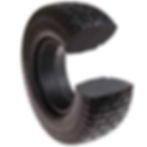Solid Rubber Tires for Skid Steers: What You Need to Know
- Galileo Wheel
- May 28
- 5 min read
If you've ever been stuck in the middle of a job because your skid steer picked up a nail, you've probably thought about solid rubber tires. No air, no flats, right? Well, it's not quite that simple. While solid tires solve some problems, they create others. Let's dig into what you're really getting into when you make the switch.
The skid steer market isn't exactly small – we're talking about a $9.4 billion industry where downtime costs real money. But before you write that check for solid tires thinking you've solved all your problems, there are some things you need to know.
What Are Solid Rubber Tires?

Think of solid rubber tires as exactly what they sound like – chunks of rubber shaped like tires. No air chamber, no inner tube, just dense rubber from rim to tread. They're built from multiple rubber compounds, often with steel reinforcement running through the middle for strength.
Of course, it's not quite that simple anymore. You'll find three main types: completely solid, resilient multi-layer designs with special cushioning layers inside for better ride quality, and aperture tires that have holes or openings to help absorb impact. There are also press-on versions that mount differently.
While these variations may help with some of the comfort issues, they don't fundamentally change the solid tire equation – you're still dealing with the basic trade-offs we'll talk about.
Unlike pneumatic tires that rely on air pressure to maintain their shape and cushioning, solid tires depend entirely on the rubber compound's properties and design features. That's both their strength and their weakness, as you'll see.
The Real Advantages of Solid Rubber Tires
Let's start with why people make the switch in the first place.
Zero Downtime from Flats
This is the big one. Construction sites, demolition jobs, scrap yards – these places eat regular tires for breakfast. When you're running through debris fields, that nail or piece of rebar isn't going to stop your day anymore. Some contractors report losing 2-3 hours per machine per week to tire issues. That's productivity you get back instantly.
Picture this: you're tearing down a building, metal everywhere. Your operator hits something sharp that would normally mean a 45-minute tire change and probably a service call. With solid tires? They might not even notice.
Lower Maintenance Requirements
No more morning pressure checks. No more wondering if that tire looks low. No more emergency repair kits bouncing around in your truck. Your maintenance crew can focus on other things, and your operators don't need to worry about tire management.
The math is straightforward – less time checking tires means more time working. For busy contractors, that's money in the bank.
Extended Lifespan in Harsh Conditions
Here's where it gets interesting. Solid tires typically last around 3-5 times longer than pneumatic tires, especially in harsh environments where they really shine. They maintain their durability while pneumatics get chewed up fast.
Gravel pits, glass recycling facilities, metal fabrication shops – these environments are solid tire territory. They grip, resist cuts, and keep working when regular tires would've given up long ago. The more aggressive your work environment, the more that durability advantage matters.
The Not-So-Great Parts (And They're Important)
Now for the stuff the tire salesman might not emphasize.
The Ride Quality Reality Check
Remember that shopping cart with the wobbly wheel? That's your solid tire experience on steroids. Solid rubber tires ride rough – really rough. We're talking about 180-220 pounds per tire of unforgiving rubber that transmits every bump, rock, and imperfection straight to your machine and operator.
Your operators will feel it. Your machine will feel it. After eight hours bouncing around on solid tires, your crew might have some opinions about the decision to switch.
They're Heavy
These things add serious weight – we're talking about an increase in rolling resistance. That means more fuel consumption, more stress on your drive system, and slower acceleration. Your machine becomes a bit of a slug. When you're loading trucks all day or need to move quickly between job sites, that extra weight matters.
Hard on Everything
Here's what might surprise you – solid tires can actually increase maintenance costs on other parts of your machine. All that vibration and jarring has to go somewhere. Operators report more wear on seats, more stress on the drive system, and generally more abuse on the entire machine.
The irony? You might save money on tires but spend it on hydraulic repairs and operator comfort.
Traction Limitations
Solid tires don't conform to surfaces the way pneumatic tires do. That means less contact patch, which translates to reduced traction and maneuverability. In muddy conditions or on slopes, you might find yourself wishing for that pneumatic flexibility.
When Solid Tires Make Sense (And When They Don't)
Solid tires aren't universally better or worse – they're different. Here's the breakdown:
Go solid when:
You're constantly dealing with punctures
Working primarily on hard surfaces
Downtime costs more than comfort
You've got aggressive debris everywhere
Machine utilization is extremely high
Don’t when:
Operator comfort matters
You need maximum traction
Working on varied terrain
Fuel efficiency is important
Your applications don't involve much debris
Alternatives? Consider Galileo SkidCups
Here's where things get interesting. While traditional solid rubber tires are basically chunks of rubber, Galileo took a different approach entirely. Instead of making tires solid, they made skid steer tires (SkidCups) airless but flexible.
The SkidCup design uses a segmented construction that actually flexes and absorbs shock – giving you about 85-90% of the shock absorption you'd get from pneumatic tires. That's a game-changer because it eliminates the biggest complaint about solid tires: the brutal ride quality.

You still get the puncture-proof benefits, but your operators won't hate you, and your machine won't shake itself apart. The CupWheel design maintains traction while eliminating flats, which is pretty much what everyone's been asking for.
At $990 for a 10-16.5 compared to about $1,200 for Michelin's X-Tweel, the price makes sense too. You're getting better performance for less money, which is exactly the kind of math that makes equipment owners happy.
Choosing the Right Approach
The truth is, there's no perfect tire. Traditional solid rubber tires solve the flat problem but create comfort and performance issues. Pneumatic tires ride great but leave you vulnerable to downtime.
If you're considering solid tires, be honest about your priorities. Can your operation handle the trade-offs? Are your operators prepared for the ride quality change? Will the fuel consumption increase fit your budget?
For many contractors, the answer is finding something in between – like the Galileo approach that eliminates flats without sacrificing everything else. Because at the end of the day, the best tire is the one that keeps your machine working efficiently without creating new problems.
The skid steer tire decision isn't just about the tire – it's about how that tire affects everything from operator retention to fuel costs to machine longevity. Make sure you're considering the whole picture, not just the puncture resistance.
